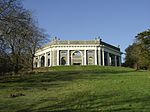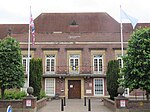Hellfire Caves
Accuracy disputes from August 2017All accuracy disputesBuildings and structures in BuckinghamshireCaves of BuckinghamshireChalk mines in England ... and 5 more
Chiltern HillsHellfire ClubReportedly haunted locations in South East EnglandShow caves in the United KingdomTourist attractions in Buckinghamshire

The Hellfire Caves (also known as the West Wycombe Caves) are a network of man-made chalk and flint caverns which extend 260m underground. They are situated above the village of West Wycombe, at the southern edge of the Chiltern Hills near High Wycombe in Buckinghamshire, Southeast England. They were excavated between 1748 and 1752 for Francis Dashwood, 11th Baron le Despencer (2nd Baronet), founder of the Society of Dilettanti and co-founder of the Hellfire Club, whose meetings were held in the caves. The caves have been operating as a tourist attraction since reopening in 1951.
Excerpt from the Wikipedia article Hellfire Caves (License: CC BY-SA 3.0, Authors, Images).Hellfire Caves
West Wycombe Hill Road,
Geographical coordinates (GPS) Address Nearby Places Show on map
Geographical coordinates (GPS)
| Latitude | Longitude |
|---|---|
| N 51.646 ° | E -0.8026 ° |
Address
Hell-Fire Tea Rooms
West Wycombe Hill Road
HP14 3AH , West Wycombe
England, United Kingdom
Open on Google Maps









